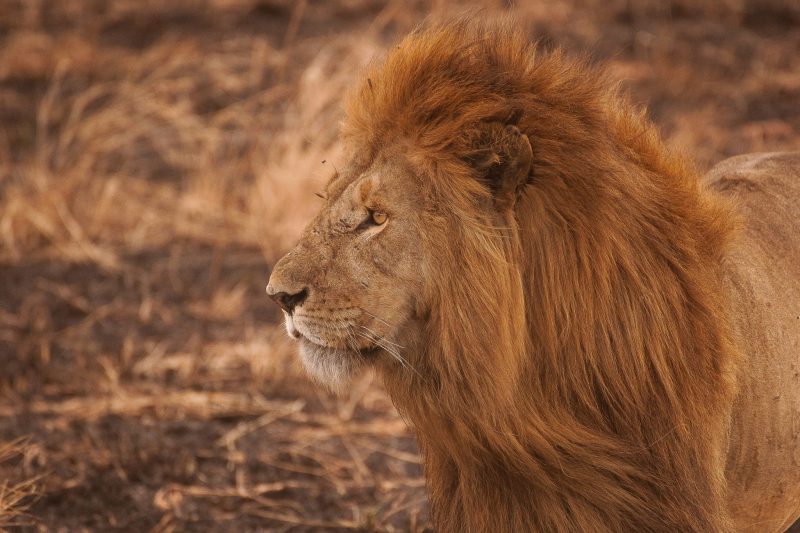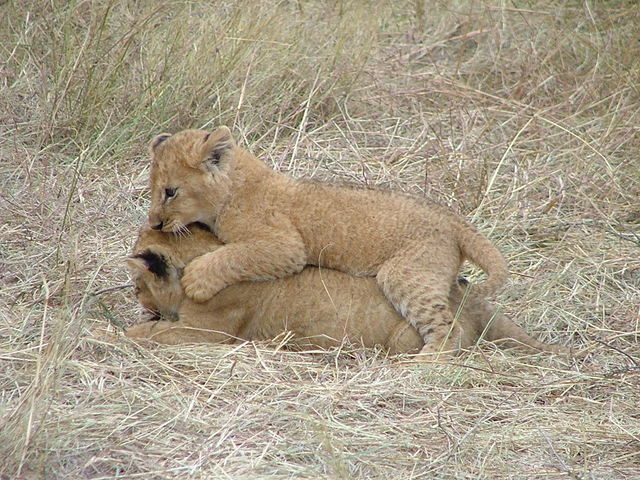-
Maasais are facing many political and socio-economic challenges. They live in inconceivable poverty and rely on relief food. Customs, activities, rituals and cattle raiding have been outlawed. Maasai leadership is losing its power because of imposed foreign concepts of development by the western front. Government policies have made Maasai way of life increasingly difficult. At this point, the sustainability of their way of living is uncertain. Although Maasai culture is transforming, its beliefs and values remain strong. Maasais who lead urbanized lifestyle happily head homewards in designer clothes, only to emerge from the Maasailand wearing their shuka and cowhide sandals.
-
Lions are susceptible to tick-borne diseases such as canine distemper and babesia. They contract distemper by eating sick domestic dogs coming from the neighboring villages. Babesia occurs when malnourished animals are vulnerable to disease during droughts. The combination of both these ailments has caused mass fatalities in lion populations. However, it is human conflict that is contributing more significantly to the decreasing rate of lion population. Because of this, Kenya Wildlife Service, in collaboration with local communities, has implemented conservation solutions. Hence, three organizations – Born Free, Lion Guardians, and American Fish and Wildlife Service – have created conservation strategies.
-
Lions are born with blue-grey color eyes, but it begins to change to an orangey brown. They have a small area called Jacobson’s organ on the roof of the mouth that allows them to taste smells. In complete contrast to humans, a lion’s tongue is so rough that if it licks the back of our hand a few times, there would be no skin left. All cats have whiskers, and the fat cats are no exception. A lion’s paws have five toes in the front and four in the back. lion has a long tail that helps it to balance.
-
To dream a lion can symbolize a defensive position. You might have a dangerous condition that has entered your life. It represents predatory feelings deep inside you. A lion in dreams also means having the ability to overcome some of your emotional issues by getting in touch with the feelings and taming them, if necessary. Some people dream of lions when they get a feeling of being preyed upon by enemies. Interestingly though, dreams of preying lion bring messages of self-sufficiency implying that you like to spend time alone because you are independent. Also, the lion spirit deals with power.
-
Lion is the only cat family member in which the males differ from the females in appearance – the mane. No other cat has it. Nobody knows for certain why a male lion has a mane and not a female. Researchers are still studying to understand as to why they have manes. So far, there are five theories as to why the males grow a mane. It protects the neck during fights. It keeps cool and clean in hot climates. The mane blends in and camouflages. The female lions get sexually attracted to the mane. And it intimidates other male
-
Published research studies shed some light on the workings of a lion’s roar. The secret lies in the vocal cords. In most species, the vocal cords are triangle-shaped and protrude into the airway. But in lions, the protrusions are shaped like squares because of the fat in the vocal cord ligament. This square shape allows the tissue to respond efficiently to passing air, allowing the roar to be louder. The studies also suggest that there is a similarity between a baby’s cry and a lion’s roar. Both have vocal cords that are gel-like that make irregular vibrations to create sounds.
-
People have used lions as a symbol for thousands of years. In some nations, lion causes fear because of the great power it wields and the fact that it walks in silent moccasins. Similarly, lion symbolizes various things in different religions and cultures. Depictions of lions are a millennium old and appear in nations across Africa, Asia, Europe, and throughout the globe. The Flag of Iran bore the Sun and Lion until 1979 from the year 1946. The coat of arms of the Netherlands, the United Kingdom, Bulgaria, Canada, Czechoslovakia, India, Spain, and Sweden has the depiction of the lion.
-
The lion is the head of the animal kingdom and thus a non-fearing animal. Hence, the most consistent depiction is the king of jungle. Since time immemorial, people have drawn inferences regarding the characteristics and features of lions and used them in lion symbolism. These inferences have diverse symbolic meaning. For example, a male lion is a symbol of power, and the lioness is the Mother. And in psychology, the lion stands for the latent passions in the unconscious. Lion parts carry different symbolism as well. Its carcass associates with honey, its head with care and its tooth with eternity.
-
Centuries ago, lions were the most ubiquitous large land mammals after humans, but today the African lion population is estimated to be a pitiful 20,000 in the wild. According to the estimates from Kenya Wildlife Service out of that roughly around 2,000 remain in Kenya. But the country is losing around 100 of them on an annual basis. According to the Fish and Wildlife Service of America, over the coming 20 years, it is projected to lose 50% of its population. In the past 20 years, its population had collapsed by 50 percent, although some put the decline rate higher.
-
A lion’s meal starts with the entrails such as the heart, kidneys, and liver. But this feral cat’s cuisine tastes vary widely. Some lions will eat everything except the stomach. Others show an adamant preference for the intestines. Some male lions prefer the flesh and will eat the hindquarters, which is the fleshiest part, while the females eat the entrails. The last part they touch is the head, and it is very unusual for them to open the skull. It’s fast-working digestive system allows them to gorge an average of 18kg in one sitting, and go for seconds shortly after.
-
A lone lion finds it difficult to catch a prey because the prey they choose to kill is faster and nimbler than the lions and can easily outrun a single lion. So, to increase their success rate, they hunt together using teamwork and smart tactics to bring it down. They form hunting parties to attack the fast animals found in the savannahs. Interestingly, the group organizes the hunting methods very well in a scientific and ruthless manner. They work cooperatively to attack the prey by forming two groups. Each lioness develops her unique role contributing to the success of killing.
-
Balloon building is a craft century in the making. The invention of one on the 4th June 1783 brings to mind two brothers, both prosperous paper manufacturers, named Joseph-Michel Montgolfier and Jacques-Etienne Montgolfier who made its first forays. They observed that heated air flowing into a fabric bag made it rise. The brothers thought that they had discovered a gas that was lighter than air. In fact, it was merely air, which became buoyant as it was heated. The bag rose because the air within was less dense and lighter than the surrounding atmosphere, which then pushed against the bottom.
-
Record Breakers In Hotair Balloon Industry On the 27th of August 1783 Jacques-Alexander-Cesar Charles, the French inventor launched a hydrogen balloon. He then went on to design and build a larger hydrogen balloon with the help of two engineering brothers Anne-Jean and Marie-Noel Robert. They included in it most of the…
-
A typical balloon ride lasts for about an hour. Weather conditions are best just after sunrise and 2 hours before sunset because light winds often occur during these timings. In between those times, when the sun is at its zenith, thermals make ballooning hazardous, although hot-air balloons can withstand temperatures of up to 250°F. But many ask how to maneuvre an hotair balloon. The launch and ground crew consisting of a minimum of four people spends much of the time inflating and deflating the balloon. Duties of the crew include launching, following in the vehicle, and getting permission for landing.
-
The pioneers of inflatable planes are unsung heroes. Mentions of them are few and far between. But giving credit where it is due is only appropriate. The pioneers of hotair balloons expounded on the buoyancy theory while designing the craft. The credit for hotair balloon invention goes to Jacques-Etienne and Joseph-Michel Montgolfier. They lived in the 18thcentury in Annonay, a town in France. Montgolfiers were paper manufacturers. Legend has it that the brothers took inspiration from watching the skirts of Joseph’s wife. The skirt billowed from the heat of a kitchen burner. Joseph’s wife used the burner to dry clothes.
-
The basket is the lowest part of the balloon, just underneath the burner. The basket is the compartment that carries the propane gas tank, the pilot, the passengers and other instruments. Baskets come in a variety of shapes and sizes. Some are smaller for private flights, and others are larger for commercial flights. It is also possible to tailor-make the basket to a set specification, from the wall height and width. Perhaps what makes wicker a resilient material would be a good follow-up read or study. If the wicker properties can assure safety in the air, it warrants further study.
-
The pilot controls an hotair balloon using the temperature inside the envelope. And the burner is the tool that he or she uses to control the temperature. That is why the burner is the engine of the balloon. An increase in the inside temperature sends the flight higher. And a decrease helps it land. In between, the pilot horizontally maneuvers it by catching the air drift at different altitudes. As the industry progresses, the world may have many other types of them. With the advancement of artificial intelligence, there might be a time when the balloon can fly even remotely.
-
The two important components of the balloon envelope are its fabric and vents. Other ballooning gears facilitate its functioning. During the flight, the pilot is always studying the altitude, pressure, and other aspects using various instruments. Pilots have a tremendous amount of control over the balloon’s rise, altitude, steering, descend and landing. They monitor it with various instruments using anticipation skills. These are equipment other than the envelope, burner and basket that the pilots use frequently. During a flight the pilot requires some of them, but not all. The instruments used during the flight are a fascinating study in itself.
-
Many people are enthusiastic about flying a hotair balloon. The next thing they do is to venture out and grab the best do-it-yourself kit available in the market. Those kits may provide information needed to make and operate a balloon but leave out the subtle nuances. For example, people wonder why the large size. They are large because of the need to create a lift that exceeds the volume of hot gas. The balloon takes an enormous amount of hot air to rise. It needs air with a temperature of 120°C and a radius of 4m to lift one person.
-
A basket, a burner and an envelope make up a hotair balloon. It’s a simple equipment. People had been using the same three components – basket, burner, envelope – for balloon ever since its invention in the 18thcentury. Although the sophistication level is higher, it still is composed of just those three things. The only difference is that the advanced technology has enabled it to fly higher, faster and safer. Perhaps by passing through the industry experience curve, balloons may be able to sustain longer distances in shorter time frame. With cutting-edge machinery, it is easy to fathom such a




















